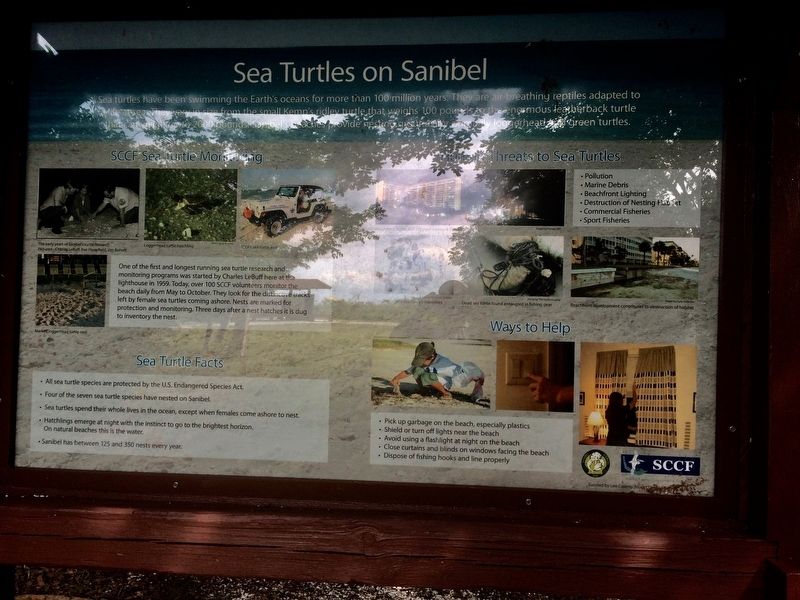Sanibel Island in Lee County, Florida — The American South (South Atlantic)
Sea Turtles on Sanibel
SCCF Sea Turtle Monitoring
The early years of Sanibel’s turtle research Pictured-Charles LeBuff Havefield, Jim Anholt
Loggerhead turtle hatchling
SCCF’s turtle jeep
Marked loggerhead turtle nests
One of the first and longest running sea turtle research and monitoring programs was started by Charles LeBuff here at the lighthouse in 1959. Today, over 100 SCCF volunteers monitor the beach daily from May to October. They look for the distinctive tracks left by female sea turtles coming ashore. Nests are marked for protection and monitoring. Three days after a nest hatches it is dug to inventory the nest.
Sea Turtle Facts
• All sea turtle species are protected by the U. S. Endangered Species Act.
• Four of the seven sea turtles species have nested on Sanibel.
• Sea turtles spend their whole lives in the ocean, except when females come ashore to nest.
• Hatchlings emerge at night with the instinct to go to the brightest horizon. On natural beaches this is the water.
• Sanibel has between 125 and 350 nests every year.
Human Threats to Sea Turtles
• Pollution
• Marine Debris
• Beachfront Lighting
• Destruction of Nesting Habitat
• Commercial Fisheries
• Sport Fisheries
Beachfront lights and skyglow disorient
Contents of one sea turtle’s intestines
Dead Sea turtle found entangled in fishing gear
Beachfront development contributes to destruction of habitat
Ways to Help
• Pick up garbage on the beach, especially plastics
• Shield or turn off lights near the beach
• Avoid using a flashlight at night on the beach
• Close curtain and blinds on windows facing the beach
• Dispose of fishing hooks and line properly
Erected by Funded by Lee County Tourism Development Council.
Topics. This historical marker is listed in these topic lists: Animals • Environment. A significant historical year for this entry is 1959.
Location. 26° 27.16′ N, 82° 0.877′ W. Marker is on Sanibel Island, Florida, in Lee County. Marker is on Periwinkle Way. Marker is located Sanibel Lighhouse Beach Park. Touch for map. Marker is at or near this postal address: 110/153 Periwinkle Way, Sanibel FL 33957, United States of America. Touch for directions.
Other nearby markers. At least 8 other markers are within 6 miles of this marker, measured as the crow flies. Mollusks and the Environment (here, next to this marker); Sanibel & Everglades Restoration (a few steps from this marker); The Beach is a wild place (a few steps from this marker); Molluscan Reproduction and Egg Case (a few steps from this marker); Sanibel Lighthouse (within shouting distance of this marker); Nature's Landlord (within shouting distance of this marker); Plants and Progress (approx. 5.4 miles away); People and Plants (approx. 5.4 miles away). Touch for a list and map of all markers in Sanibel Island.
Also see . . .
1. Loggerhead sea turtle. The loggerhead sea turtle (Caretta caretta), or loggerhead, is an oceanic turtle distributed throughout the world. It is a marine reptile, belonging to the family Cheloniidae. The average loggerhead measures around 90 cm (35 in) long when fully grown, although larger specimens of up to 280 cm (110 in) have been discovered. The adult loggerhead sea turtle weighs approximately 135 kg (298 lb), with the largest specimens weighing in at more than 450 kg (1,000 lb). The skin ranges from yellow to brown in color, and the shell is typically reddish brown. No external differences in sex are seen until the turtle becomes an adult, the most obvious difference being the adult males have thicker tails and shorter plastrons than the females. (Submitted on July 29, 2017, by Sandra Hughes Tidwell of Killen, Alabama, USA.)
2. Green sea turtle. he green sea turtle (Chelonia mydas), also known as the green turtle, black (sea) turtle, or Pacific green turtle, is a large sea turtle of the family Cheloniidae. It is the only species in the genus Chelonia. Its range extends throughout tropical and subtropical seas around the world, with two distinct populations in the Atlantic and Pacific Oceans, but it is also found in the Indian Ocean. The common name comes from the usually green fat found beneath its carapace; these turtles' shells are olive to black. (Submitted on July 29, 2017, by Sandra Hughes Tidwell of Killen, Alabama, USA.)
Credits. This page was last revised on August 3, 2017. It was originally submitted on July 29, 2017, by Sandra Hughes Tidwell of Killen, Alabama, USA. This page has been viewed 163 times since then and 10 times this year. Photo 1. submitted on July 29, 2017, by Sandra Hughes Tidwell of Killen, Alabama, USA. • Bill Pfingsten was the editor who published this page.
